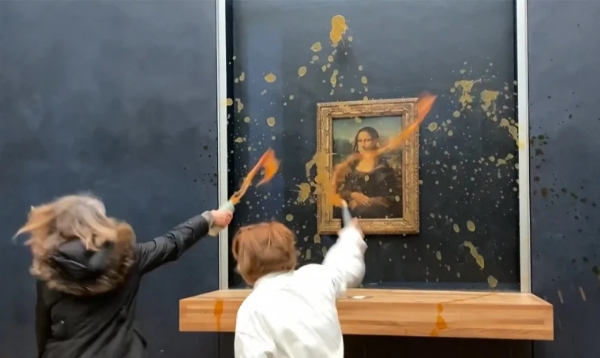'Environment activists' throw soup at iconic Mona Lisa painting in Paris; AI explains recovery
Despite its fame, the Mona Lisa has faced previous incidents of vandalism and theft.
Total Views |
Paris, Jan 29: Protesters targeted the iconic Mona Lisa painting in Paris on Sunday (Jan 28), hurling soup in an act of vandalism, CNN reported. Fortunately, the famous artwork, displayed at the Louvre Museum, remained unharmed as it is protected by a clear casing.

An environmental group, Riposte Alimentaire, claimed responsibility for the incident on X (formerly Twitter). The group stated that two individuals involved in their campaign were responsible for spraying soup on the world-renowned Mona Lisa, according to CNN. Leonardo da Vinci's masterpiece, a small portrait measuring just over 2.5 feet tall and under 2 feet wide, attracts millions of visitors annually. Despite its fame, the Mona Lisa has faced previous incidents of vandalism and theft.
In 1911, it was stolen by a Louvre employee, gaining international attention. Protective measures were subsequently heightened, including the installation of bulletproof glass, after an acid attack in the 1950s damaged the bottom of the canvas. The Mona Lisa has endured various attempts at vandalism over the years. In 2009, a woman threw a ceramic cup at the painting, causing damage to the cup but leaving the artwork unscathed. In 2022, a visitor smeared frosting on the protective glass surrounding the Renaissance-era masterpiece, as reported by CNN.
Climate activists just saved the planet. They threw soup on the Mona Lisa. pic.twitter.com/xAtTf0Z9vY
— End Wokeness (@EndWokeness) January 28, 2024
Here's how AI has explained the process to clean stains on such an antique:
Recovering a valuable painting like the 'Mona Lisa' from stains, such as those caused by hurling soup, necessitates a meticulous and scientific approach. The process begins with documenting and analyzing the current condition of the painting, identifying the nature of the stains, and assessing potential risks associated with cleaning. Small-scale tests are conducted on inconspicuous areas to determine the most suitable cleaning agents. The selected agents are then applied cautiously, with continuous monitoring of the cleaning process. Following cleaning, thorough rinsing and neutralization are essential to eliminate residues and prevent further chemical reactions.
The painting is dried in a controlled environment, and if necessary, additional restoration work is undertaken. Throughout the restoration, experts in art conservation and chemistry are consulted to ensure the appropriateness of methods used. The entire process is meticulously documented, including materials, methods, and changes observed. Permission from relevant authorities is crucial, and periodic evaluations are conducted to monitor the long-term stability of the restored painting. Professional expertise is paramount in art restoration, particularly for renowned works like the 'Mona Lisa.' Art restoration professionals must adhere to ethical guidelines and best practices to safeguard the integrity of the artwork.
--


